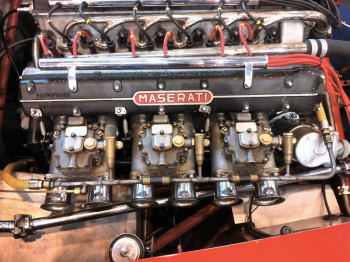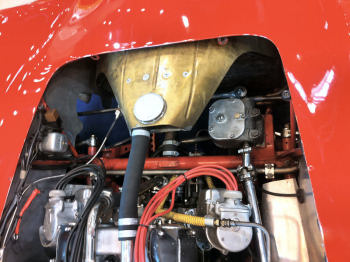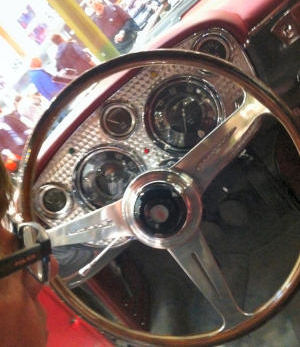| The Enthusiasts' Page | |||
All things 'Maserati'. News of forthcoming models, owner's cars, tips, 'Marque' reunions and the odd touch of humour ! In fact anything of interest to the 'Maseratista'. |
 |
||
| You can click on some pictures for a better view !! | |||
| YOU ARE NOW ON PAGE 265 | ||
|
|
||
|
|
||
| AUTO ITALIA'S TRIBUTE TO MASERATI | ||
Ciao Maseratisti, |
||
 "Maserati Centenario" by Auto Italia |
||
Recorded by Auto Italia contributor Simon Park, "Maserati Centenario" follows the Maserati story from its roots in Diatto, through the Orsi dynasty, the Citroen years, the De Tomaso episode and finally Ferrari and the current Fiat administration. The dream of Fratelli Maserati all those years ago has finally been realised with Maserati becoming one of the most recognised and respected exclusive car marques. |
||
 |
||
|
|
||
|
|
||
| MODENA MOTOR GALLERY 2014 | ||
Maseratisti, |
||
1929 - A crankshaft from the engine of the Maserati Tipo V4 |
||
©Dott. Matteo Panini |
||
A 5-bearing crankshaft derived from the Tipo 26B engine. The combination of the two blocks in a single-cylinder engine casing allowed Alfieri Maserati to achieve a high displacement whilst limiting the transverse dimensions. Each group of eight cylinders was independent, with its own magneto, carburettor, supercharger and crankshaft. Unique and a crucial link was the heavy-duty connecting gear linking the two flywheels. Note that the external main and centre bearings are roller bearings. |
||
1935 - Steering box from the Maserati Tipo V8 RI |
||
©Dott. Matteo Panini |
||
With the introduction of independent suspension in place of the classic rigid axle, a new concept in steering was designed: the box in Elektron, fixed on the clutch bell housing, was of dual effect. Under the action of the steering wheel it caused the two steering arms, one for each wheel, to move in opposite directions, which were the only controls elements. With this system one could keep the wheels in line under braking and enhance the ease of driving. |
||
1939 - Crankshaft from the Maserati 6CM 1.5-litre 24-valve engine |
||
©Dott. Matteo Panini |
||
The crankshaft from final evolution of the Tipo 6CM engine that initiated the era of the 1939 Tipo 4CL. This engine debuted in Naples and later won the Kahlernberg hillclimb in Germany with Paul Pietch at the wheel. The 6CM 24-valve reappeared on the scene in 1946 at the Nice GP in the hands of Phlippe Etancelin. In this final evolution of the engine, its power reached almost 180 bhp at 6,600 rpm. |
||
1955 - Maserati 250F cylinder head with desmodromic valves and fuel injection |
||
©Dott. Matteo Panini |
||
©Dott. Matteo Panini |
||
©Dott. Matteo Panini |
||
©Dott. Matteo Panini |
||
©Dott. Matteo Panini |
||
©Dott. Matteo Panini |
||
Between 1954 and 1955, an experimental Maserati 250F engine was built with a desmodromic valve train and either direct or indirect fuel injection (including alcohol) to achieve a higher power output. The first desmo project at Maserati was initiated in 1943 by Ernesto Maserati with some later modifications by Technical Director Ing Giulio Alfieri. Another system was also researched by Ing. Massimino in 1944, and it was through these early studies that Maserati was able to produce this head. The engine, however, even though limited to 10,000 rpm, did not produce the power anticipated, and the desmo project was finally shelved. |
||
1957 - Cylinder head from the Maserati 2.5-litre V12 engine |
||
©Dott. Matteo Panini |
||
The twelve-cylinder Maserati debuted at the French Grand Prix at Reims in 1957. It was equipped with four overhead gear-driven camshafts; each valve was fitted with two needle hair-pin springs (this would be the last engine to employ these types of springs). The intake manifolds were of "downdraft" type ", in other words arranged inside the V formed by the valves of each cylinder bank. By the end of the 1957 season this engine had achieved a power output of 300 bhp at 9,800 rpm. |
||
1961 - Maserati Tipo 64 "Birdcage" rear chassis with De Dion tube and torsion bars |
||
©Dott. Matteo Panini |
||
Produced from 1961 to 1962, the Tipo 64 was the natural evolution of the Tipo 63, which in turn arose from the front-engined Tipo 60/61. The 64 had a lattice-framed chassis consisting of over 200 sections of Chrome-Molybdenum steel tubes of three different diameters: 10, 12 and 15 mm and had a new rear suspension with a De Dion axle and unique Amadori wheels in forged magnesium. Other changes were introduced to improve weight distribution. The first model had a body designed by Franco Scaglione, a former designer at Bertone, and was built by Gentilini and Allegretti for Scuderia Serenissima. The set of tubes welded together formed a true trellis with the advantage of reducing weight while increasing stiffness. The 3-litre rear engine had a power output of 320 bhp at 8,500 rpm. |
||
1965 - A single-cylinder experimental engine for the Maserati V12 Tipo 9 engine |
||
©Dott. Matteo Panini |
||
A single-cylinder engine made in 1965 for the development of the F1 V12 engine to equip the Cooper F1 cars. From the Dell'Orto motorcycle-type carburettors, we move on to the Lucas direct fuel injection system, and bore and stroke were soon revised, from 70.4 x 64 mm to 75.2 X56 mm. The reduction in stroke permitted higher engine speeds and the adoption of larger valves; towards the end of the season, power output had risen to 360 hp at 9200 rpm, with a compression ratio of 11:1. |
||
1966 - Cylinder head from the experimental Maserati V12 Tipo 10 engine with 3 valves per cylinder |
||
©Dott. Matteo Panini |
||
An experimental 3-valve cylinder head for the development of the new F1 engine for Cooper cars in the Formula 1 66/67 season. The valves (two intake and one exhaust) were all parallel to each other with two camshafts and dual ignition. The combustion chamber was formed internally in the crown of the piston and, thanks to the very compact well formed design, it was possible to adopt a very high compression ratio (11.8:1) to the benefit of thermal efficiency. The development of this new engine lasted all season and maximum power passed from the initial 375 bhp at 9,500 rpm to more than 390 bhp at 10,000 rpm. This was the swan song of the Maserati V12, because at the end of the year its career came to an end. |
||
1968 - An experimental cylinder head with four valves per cylinder for the Maserati Ghibli 4.9 Tipo 115 engine |
||
©Dott. Matteo Panini |
||
A pair of cylinder heads built specifically for Sig. Paini of Verona, a customer very fond of the “Casa del Tridente” of Modena. The heads were mounted on his red 4.9-litre Ghibli, chassis No AM 115/49*314*, in exchange for using the car for"road testing" as Mr. Paini drove many miles in his Maserati. With these heads the engine was capable of delivering over 330 bhp for a top speed of over 280 kph. Projects already underway for the new Khamsin prevented proper development of this engine, which remained at the prototype stage. |
||
1985 - Cylinder head from the experimental Maserati Biturbo V6 36-valve engine |
||
©Dott. Matteo Panini |
||
With the patent number 22710A/85 Maserati in 1985 presented the 6:36 engine: a 2-litre V6 with six valves per cylinder producing 261 bhp at 7200 rpm. The valve train system was named "finger control": a single command that moved three valves at the same time. Valve clearance adjustment was of the traditional type via screw and lock nut. |
||
1981-1988 - 2.0-litre V6 engine of the Maserati Biturbo 2000 |
||
 |
||
The Maserati Birurbo sported a chrome grille, four headlights and a trident in prominence, a wedge-shaped design, a characteristic sound, a multi-valve cylinder head and many, many, many wild horses. This "revolutionary" six cylinder engine V6 @ 90° of only 1996 cc was designed for the Biturbo of De Tomaso on December 14 1981 in order to allow a wider distribution among fans of the "Modena trident" and avoid the taxation penalties reserved for large-displacement sports cars at that time. |
||
2004 - Engine of the Maserati MC12 GT1 |
||
 |
||
This is the engine mounted on the Maserati MC12 GT1, winner of the 2005 FIA GT Championship. The MC12 was a mid-engined car rear longitudinal and rear wheel drive. The engine is a V12 @ 65° with a displacement of 5,998 cc fitted with restrictor plates on the intake manifolds (imposed by the technical rules of the FIA GT) to limit power ouput to 650 bhp. The race version for customers without restrictor plates could reach 755 bhp at 8,000 rpm. This unit had a compression ratio of 11.2:1. The 6-speed semi-automatic "Maserati Cambiocorsa" type transmission was similar to that fitted to the 6-speed "Maserati Cambiocorsa", and with a weight of 1,150 kg. it reached a top speed of over 330 kph. |
||
|
|
||
|
|
||
| MASERATI A6G 2000 SPYDER BY FRUA | ||
Ciao Maseratisti, |
||
 The Maserati A6G 2000 Spyder by Frua by ABC |
||
|
|
||
|
|
||
| A MASERATI MERAK V8 | ||
"Hello. |
||
 Kevin's Maserati Merak |
 |
|
 |
 |
|
 |
 |
|
 |
 |
|
 |
 |
|
 |
 |
|
 |
 |
|
 |
 |
|
 |
 |
|
 |
 |
|
Reply from Enrico: |
||
|
|
||
|
|
||
| MASERATI MERAK V8 CLICKING NOISE !!! | ||
"Hi Henry, |
||
|
|
||
|
|
||
| MASERATI SHAMAL | ||
"Hi Enrico, |
||
 Maserati Shamal |
||
|
|
||
|
|
||
| WARNING: POSSIBLE SELLING SCAM !!! | ||
Maseratisti, |
||
|
|
||
|
|
||
| MASERATI'S "CENTENNIAL GATHERING" | ||
Details of the provisional programme of events for the Maserati International "Centennial Gathering" have been released. |
||
 |
||
 |
||
The three-day meeting will commence in Modena, moving on to Cremona, then on to Turin, finishing at the new Maserati factory at Grugliasco. |
||
 |
||
Participants will be free to roam around the Piazza Maggiore and Piazza del Nettuno for a rare and unique photo opportunity and visit the site of the first Maserati workshop. |
||
 |
||
As participants check in they will position their cars in Modena's main Piazza. They will then be able to tour the factory and be invited to an exclusive Walking Dinner Experience with surprising performers and opera singers. |
||
 |
||
Participants leave Modena, heading towards the San Marino del Lago circuit in Cremona. Here they will test the track and relax in the Maserati Lounge Area. Lunch will also be served at the circuit. |
||
 |
||
In the morning, cars will depart from Piazza Castello to Grugliasco, home of the AGAP factory. Guests will be able to visit the plant. The location will be the setting for a light lunch before the final leg of the day. |
||
|
|
||
|
|
||
| TECHNO CLASSICA ESSEN 2014 | ||
"Ciao Enrico, |
||
 Maserati Quattroporte III |
 |
|
 Maserati 3500 GT |
 |
|
 La targa italiana (La Spezia, Liguria) !! |
 Maserati Khamsin |
|
 Maserati 300S |
 |
|
 The Maserati MC12 or the Jaguar XJ 220 ? Which one would you choose ??? |
 I think I'll take the Maserati MC12 !!! |
|
 Maserati Ghibli |
 |
|
 Maserati Ghibli |
 |
|
 Maserati Biturbo Coupe 1a serie |
 Maserati A6 1500 Pinin Farina |
|
 Maserati A6G 2000 Frua Spyder |
 Maserati artwork |
|
 Period crash helmet ( www.autotechnikauktion.de ) |
 Maserati Tipo 61 by Drogo |
|
 De Tomaso Mangusta GT |
 OSCA PR2 by Fissore |
|
 The "patient" appears to be in good hands, but will he survive after he gets the bill !!! |
 Parts on display by Crosthwaite & Gardiner |
|
 Maserati Biturbo headlights for sale ! |
 Diplodocus barbecue ! Oggi, cosa possiamo mangiare di buono ??? |
|
 Magnificent Maserati diorama |
||
|
|
|||||||||||||||||
|
|
|||||||||||||||||
| FIAT ABARTH | |||||||||||||||||
"Hi there Enrico, How are things with you ? Hope you and yours are well and enjoying life. Remember the article you sent to us all, about the Abarth 695 Biposto, and I replied with a further story about the Oakley 240bhp 695 special, then you asked if you could put my story on your website after reading about my racing my Abarths in the ‘50s & ‘60s ? Well I have remembered a little more detail, as to who I personally bought my 1,000 TCR from, obviously it was as told to you previously, as I got it from Radbourne Racing, but I forgot who sold it and serviced it for me. It was the Anstead Brothers, Geoff & John Anstead and their business partner Gladstone Small, who brought in the cars from Italy, with all the Abarth parts separately, and built them up here in their workshops in London, they charged by an uncomplicated menu, £1 for each Cubic Centimetre, so a 595 Abarth was £595, an 850 Abarth was £850, and a 1,000 Abarth at £1,000. This was quite unique in those days, and we were all as customers, allowed to peruse through the workshops and check if there was anything else we needed, to ensure your car was unique depending on whether you were to use your car on the road or on the track. It was a great way of doing business and their customers, like me, were looked after quite well, and We enjoyed our time with them. One day I remember they phoned me and asked if I would be at all interested in putting a 1,300cc engine from an Abarth Spyder in the back of my TCR ! I could not afford to do that then, and about a year later the Abarth Factory introduced the 1,300 in a Fiat 850 body, swiftly followed by a 1,600 and finally a 2,000cc engine was introduced. It was a real stormer, produced 240 bhp and was quite quick in those days, I have the full details in my Abarth Manual of ALL models produced by them from start to finish, including the record attempt cars, it is a wonderful book, I love reading it and remembering what I did many years ago when I was young! See you soon I hope, Regards, Peter.
| |||||||||||||||||











































































































































